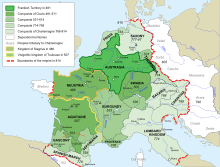Duchy of Thuringia
Duchy (Landgraviate) of Thuringia Herzogtum (Landgrafschaft) Thüringen | |||||||||||
|---|---|---|---|---|---|---|---|---|---|---|---|
| 631/32–1440 | |||||||||||
The Ludowingian
lion barry (presumed banner of arms) | |||||||||||
| Status | Roman Catholicism | ||||||||||
| Government | Feudal Duchy | ||||||||||
| Historical era | Middle Ages | ||||||||||
• Frankish invasion | c. 531 | ||||||||||
• Duchy established | 631/32 | ||||||||||
• Re-established as Landgraviate | 1111/12 | ||||||||||
| 1247 | |||||||||||
• Split off Hesse | 1264 | ||||||||||
• To Saxony | 1440 | ||||||||||
| 1445 | |||||||||||
| |||||||||||
The Duchy of Thuringia was an eastern
History

The former kingdom of the
The Thuringian realm was shattered: the territory north of the Harz mountain range was settled by Saxon tribes, while the Franks moved into the southern parts on the Main River. The estates east of the Saale River were beyond Frankish control and taken over by Polabian Slavs.
Merovingian duchy

The first documented duke (dux) of remaining Thuringia was a local noble named Radulf, installed by King Dagobert in the early 630s. Radulf was able to secure the Frankish border along the Saale River in the east from Slavic incursions. However, according to the Chronicle of Fredegar, in 641/2 his victories "turned his head" (i.e., made him proud) and he allied with Samo and rebelled against Dagobert's successor, King Sigebert III, even going so far as to declare himself king (rex) of Thuringia.[2][3] A punitive expedition led by the Frankish Mayor of the Palace Grimoald ultimately failed and Radulf was able to maintain his semi-autonomous position. His successors of the local ducal dynasty, the Hedenen, supported missionary activity within the duchy, but seem to have lost their hold on Thuringia after the rise of the Pippinids in the early eighth century. A conflict with Charles Martel around 717–19 brought an end to autonomy.[4]
In 849, the eastern part of Thuringia was organised as the
Landgraviate


A separate Thuringian stem duchy did not exist during the emergence of the
Meanwhile, the
Beside the Wartburg, the Ludowingian landgraves had further lavish residences erected, like

The last Thuringian landgrave
As a result, Henry of Meissen gained the bulk of Thuringia in 1264, while the Hessian possessions of the landgraves were separated as the
Rulers
Dukes
- "Older" stem duchy
- 632–642 Radulf (I)
- 642–687 Heden I
- 687–689 Gozbert
- 689–719 Heden II
- "Younger" stem duchy
- 849–873 Thachulf
- 874–880 Radulf (II)
- 880–892 Poppo
- 882–886 Egino (in opposition)
- 892–906 Conrad
- 907–908 Burchard
Landgraves
- 1111/12 Herman of Winzenburg
- Ludowingians
- 1131–1140 Louis I
- 1140–1172 Louis II
- 1172–1190 Louis III
- 1190–1217 Hermann I
- 1217–1227 Louis IV
- 1227–1241 Hermann II
- 1241–1247 Henry Raspe
- 1247–1265 Henry III, Margrave of Meissen
- 1265–1294 Albert II, Margrave of Meissen 1288–1292
purchased by King
- 1298–1323 Frederick I, Margrave of Meissen, jointly with his brother
- 1298–1307 Theodoric IV, Landgrave of Lusatia
- 1323–1349 Frederick II, Margrave of Meissen
- 1349–1381 Frederick III, jointly with his brothers
- 1406–1440 Frederick IV
Notes
- ISBN 978-0-19-866262-4.
- ISBN 0582081564.
- ISBN 0521802024.
- ISBN 9004117237.
- ^ Flynn, Christopher (2020). "Military History in East Francia under King Louis the German (c. 825-876)" (PDF). University of Minnesota.
- ISBN 0719034574.
- ^ Reuter, Annals of Fulda, s. a. 882 and 883.
- ^ Reuter, Germany in the Early Middle Ages, 123.
- ^ Reuter, Germany in the Early Middle Ages, 129.
- ISBN 0813391539.
- ISBN 0932269664.
- ^ Reuter, Germany in the Early Middle Ages, 133.
Further reading
- Gerd Tellenbach. Königtum und Stämme in der Werdezeit des Deutschen Reiches. Quellen und Studien zur Verfassungsgeschichte des Deutschen Reiches in Mittelalter und Neuzeit, vol. 7, pt. 4. Weimar, 1939.


